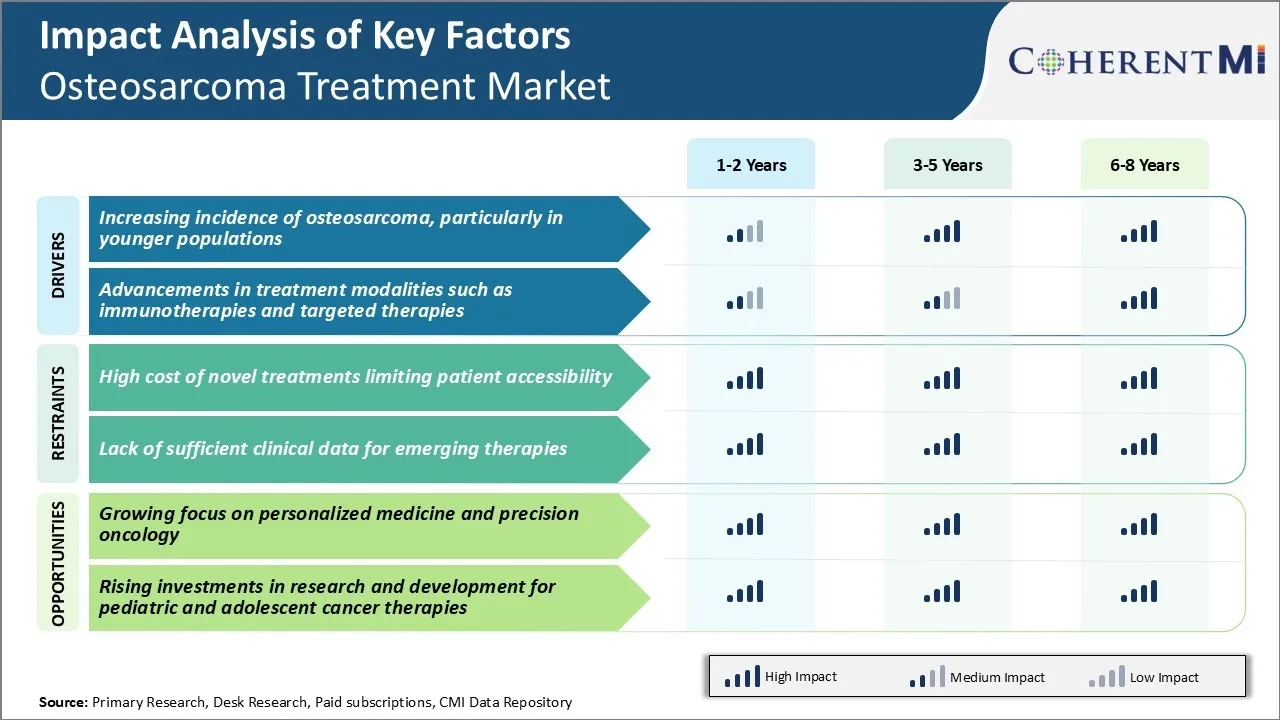Osteosaroma Behandlungsmarkt GRÖSSEN- UND MARKTANTEILSANALYSE - WACHSTUMSTRENDS UND PROGNOSEN (2024 - 2031)
Osteosarcoma Behandlungsmarkt wird durch Behandlung (Chemotherapie, Targeted Therapy, Immuntherapie), By Disease Stage (Early Stage, Advanced Stage), ....
Osteosaroma Behandlungsmarkt Trends
Markttreiber - zunehmende Inzidenz von Osteosarcoma, vor allem in jüngeren Bevölkerungen
Statistiken zeigen die jährliche Häufigkeitsrate von Osteoarkom auf rund 4 Fälle pro Million Personen. Studien aus Nordamerika und Teilen Europas haben das durchschnittliche jährliche Auftreten von Jugendlichen im Alter von 10 bis 24 Jahren auf über 8 Fälle pro Million festgestellt. Noch beunruhigender, einige asiatische Länder haben die Jugendraten so hoch wie 10-12 Fälle pro Million Menschen gemeldet.
Die jüngere Demographie des Patienten ist ein wichtiges Anliegen, da Osteoarkom während der Kindheit oder Teenagerjahre diagnostiziert oft eine aggressivere Form der Krankheit zeigt. Jüngere Knochen entwickeln sich noch, was es den Krebszellen ermöglicht, schneller zu verbreiten. Leider ist die verzögerte Diagnose vor allem in benachteiligten Regionen mit eingeschränktem Zugang zu fortgeschrittenen Gesundheitseinrichtungen üblich. Dies trägt zu schlechteren klinischen Ergebnissen bei und reduziert die Gesamtüberlebensrate.
Mit dem Wachstum der globalen Bevölkerung und den Altersstrukturen, die in den Entwicklungsländern jünger werden, steigt das schiere Volumen der gefährdeten Individuen jährlich. Es sei denn, es werden konzertierte Anstrengungen unternommen, um die zugrunde liegenden erblichen und umweltbedingten Ursachen zu drosseln, während die Programme zur Früherkennung von Krebserkrankungen weltweit gestärkt werden, werden die steigenden Inzidenztrends in den kommenden Jahrzehnten fortbestehen und möglicherweise sogar beschleunigen. Dies stellt einen bedeutenden Treiber für die weitere Forschung zu effektiveren und erschwinglichen therapeutischen Lösungen dar.
Markttreiber - Fortschritte bei der Behandlung Modalitäten wie Immuntherapien und gezielte Therapien
Während Osteosarkom eine schwer zu behandelnde Art von Krebs mit historisch niedrigen Überlebensraten bleibt, hat der Bereich der Onkologie in den letzten Jahren enorme Fortschritte erlebt. Fortschritte beim Verständnis der molekularen Grundlagen der Krankheit haben die Entwicklung neuartiger, gezielter Therapieansätze ermöglicht. Zusammen mit schnellen technologischen Verbesserungen hat dies die osteosarkom-Behandlungslandschaft transformiert und neue Optimismus bei Patienten und der medizinischen Gemeinschaft gefördert.
Immuntherapien, die die Macht des eigenen Immunsystems nutzen, sind an der Spitze der Innovation. Checkpoint Inhibitoren zur Freisetzung von Bremsen auf Immunreaktionen haben in frühen klinischen Studien Versprechen gezeigt. Dazu gehören Medikamente, die auf den PD-1/PD-L1-Weg abzielen, den viele Tumoren zur Detektion nutzen. Fortlaufende Studien erweitern unser Wissen darüber, wie Immuntherapien am besten in serienmäßige Chemotherapeutika integriert werden können. Inzwischen, chimärer Antigenrezeptor (CAR) T-Zelltherapien werden ebenfalls untersucht. Durch die eigenen T-Zellen von Ingenieurpatienten, um Tumor-spezifische Antigene zu erkennen, haben CAR-Ts komplette Remissionen bei Blutkrebs ausgelöst und zukünftige Potenziale für solide Tumore halten.
Parallel haben molekular zielgerichtete Mittel, die Tumoren' Aberrant Growth Signaling Pathways hemmen, im Vergleich zur herkömmlichen Chemotherapie deutlich verbesserte Ergebnisse. Dies wird einen erheblichen Einfluss auf das Wachstum des Osteoarkombehandlungsmarktes haben.

Markt-Herausforderung - hohe Kosten für neuartige Behandlungen Begrenzung der Patienten-Erreichbarkeit
Die Kosten für neuartige und fortgeschrittene Behandlungen für Osteoarkom, wie Immuntherapien und gezielte Therapien, sind für viele Patienten enorm verbietend. Diese neuen Behandlungsoptionen bieten bessere Überlebensergebnisse im Vergleich zu herkömmlichen Chemotherapie-Regime.
Jedoch können ihre Kosten oft in Hunderttausende von Dollar für einen vollen Kurs der Behandlung laufen. Da Osteosarkom eine seltene Krebsart ist, können Pharmaunternehmen für diese Therapien keine signifikanten Verkaufsmengen realisieren. Dieser Risikofaktor spiegelt sich dann in der Preisgestaltung dieser Medikamente wider.
Der Mangel an einem beträchtlichen Patientenpool macht es für Unternehmen finanziell unwahrscheinlich, diese neuartigen Behandlungen zu erschwinglichen Preispunkten anzubieten. Dadurch haben nur Patienten mit starkem Versicherungsschutz oder tiefen Taschen Zugang zu neuesten Behandlungsinnovationen. Diese wirtschaftliche Barriere begrenzt die Durchdringung der fortgeschrittenen Pflege, insbesondere in den Entwicklungsländern.
Auch in den entwickelten Märkten zwingen hohe Kosten für den Ausfall von Patienten oft zu günstigeren, aber relativ weniger effektiven Optionen wie der generischen Chemotherapie. Dies stellt eine bedeutende Herausforderung für die Verbesserung der klinischen Ergebnisse auf einer Bevölkerungsebene für Osteoarkom dar.
Marktchance - zunehmender Fokus auf personalisierte Medizin und Precision Onkologie für Markt
Im Bereich der Onkologie steht der Schwerpunkt auf der Entwicklung personalisierter und präziser Behandlungsansätze. Diese Schicht bietet vielversprechende Möglichkeiten für den osteosaroma Behandlungsmarkt. Mit Fortschritten bei der genetischen Profilierung und gezielten diagnostischen Tests haben Onkologen nun ein besseres Verständnis der molekularen Eigenschaften einzelner Patiententumoren. Dies ermöglicht mehr stratifizierte Behandlungsentscheidungen auf Basis der einzigartigen genetischen Signatur und Biomarker eines Patienten.
Mehrere Pharmaunternehmen investieren aktiv in die Erforschung und Entwicklung maßgeschneiderter Therapien für spezifische genomische Veränderungen, die in Osteoarkomtumoren auftreten. Die Erkenntnisse aus Big Data Analysen helfen auch Biomarker zu identifizieren, die Drogenreaktionen vorhersagen können. Dieser wachsende Fokus auf personalisierte Medizin und Präzisions-Onkologie zielt darauf ab, die Wirksamkeit der Behandlung zu maximieren und gleichzeitig die Toxizität für Osteokompatienten zu minimieren.
Es könnte zu verbesserten klinischen Ergebnissen führen. Es kann auch den pharmazeutischen Spielern helfen, die richtigen Patientenpopulationen für neue Drogenkandidaten besser zu bestimmen und die kommerzielle Rentabilität zu verbessern. Diese Verschiebung ist gut für zukünftige Wachstumsaussichten auf dem osteosaroma-Behandlungsmarkt.